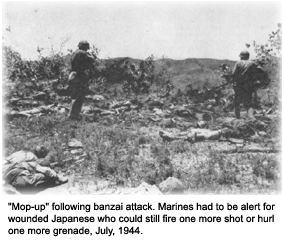The noun banzai (pronounced bonzEYE) means a Japanese patriotic cheer or battle cry.
A banzai counterattack by the Japanese during World War II was typically the outcome of an operational failure, becoming the final effort to turn the tide of battle, or die in the attempt.
A gruesome aspect of banzai counterattacks was that if the Japanese ran out of ammunition or failed to overrun the enemy, then they committed suicide. At the time of World War II, the Japanese held a slight technological advantage over the United States, and they did not want any other countries to gain knowledge of their weapons. The soldiers were indoctrinated that, in the event of a Banzai charge, they were to kill themselves to avoid capture, if the counterattack failed. That prevented them from being interrogated and forced into giving information to the enemy.
 American soldiers first confronted a banzai charge during the Thousand-Mile War in the Aleutian Islands. In the night of May 28, 1943, Japanese soldiers on the verge of defeat at Chichagof Harbor on Attu, ran directly into an American camp, first to bayonet the sleeping soldiers, then kill themselves if they couldn't break through to the other side.
Japanese soldiers were taught that if communication lines were cut, then everyone was to stay in place and fight to the death. On the other hand, the yell “Tenno Haika! Banzai!” meaning “Long live the Emperor! Ten thousand ages!” signaled a charge en masse at the enemy.
The extreme behavior of the banzai charge* without regard to casualties is supposedly rooted in the ancient samarai Bushido code of death, honor, and loyalty to the emperor. But it also can be attributed to the cynical manipulation of common men by military leaders left with no other options.
Notable battles in which Banzai charges took place:
American soldiers first confronted a banzai charge during the Thousand-Mile War in the Aleutian Islands. In the night of May 28, 1943, Japanese soldiers on the verge of defeat at Chichagof Harbor on Attu, ran directly into an American camp, first to bayonet the sleeping soldiers, then kill themselves if they couldn't break through to the other side.
Japanese soldiers were taught that if communication lines were cut, then everyone was to stay in place and fight to the death. On the other hand, the yell “Tenno Haika! Banzai!” meaning “Long live the Emperor! Ten thousand ages!” signaled a charge en masse at the enemy.
The extreme behavior of the banzai charge* without regard to casualties is supposedly rooted in the ancient samarai Bushido code of death, honor, and loyalty to the emperor. But it also can be attributed to the cynical manipulation of common men by military leaders left with no other options.
Notable battles in which Banzai charges took place: